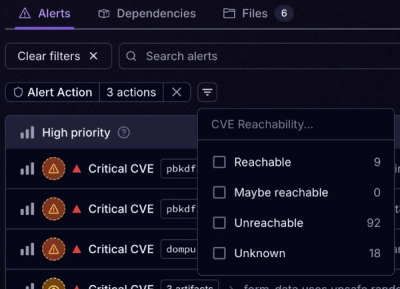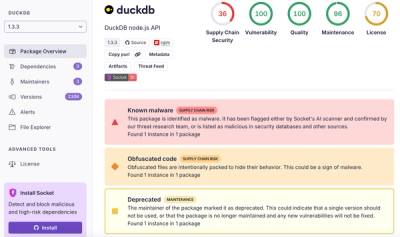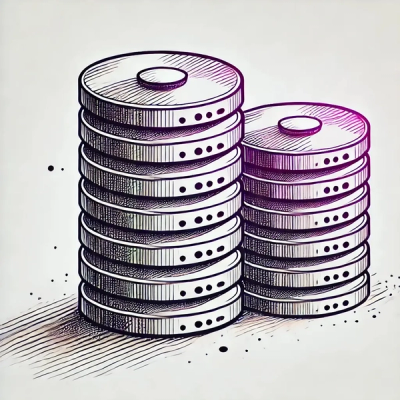
Product
Introducing Tier 1 Reachability: Precision CVE Triage for Enterprise Teams
Socket’s new Tier 1 Reachability filters out up to 80% of irrelevant CVEs, so security teams can focus on the vulnerabilities that matter.
aframe-physics-system
Advanced tools
Components for A-Frame physics integration. Supports CANNON.js and Ammo.js
Ammo.js driver support has been added. Please see Ammo Driver for documentation. CANNON.js support may be deprecated in the future.
In the dist/ folder, download the full or minified build. Include the script on your page, and all components are automatically registered for you:
<script src="https://cdn.jsdelivr.net/gh/n5ro/aframe-physics-system@v$npm_package_version/dist/aframe-physics-system.min.js"></script>
CDN builds for aframe-physics-system@v$npm_package_version:
npm install --save aframe-physics-system
// my-app.js
require('aframe-physics-system');
Once installed, you'll need to compile your JavaScript using something like Browserify or Webpack. Example:
npm install -g browserify
browserify my-app.js -o bundle.js
bundle.js may then be included in your page. See here for a better introduction to Browserify.
When using webpack, you need to ensure that your loader for .js files includes this dependency. The example below assumes you're using Babel.
{
test: /\.js$/,
include: ['src', require.resolve('aframe-physics-system') ],
use: {
loader: 'babel-loader', // or whatever loader you're using to parse modules
options: {}
}
}
Note: You cannot use
exclude: /node_modulesfor your.jsloader. You must instead useincludeand pass an array of directories as dependencies to transpile.
<!-- The debug:true option creates a wireframe around each physics body. If you don't see a wireframe,
the physics system may be unable to parse your model without a shape:box or shape:hull option. -->
<a-scene physics="debug: true">
<!-- Camera -->
<a-entity camera look-controls></a-entity>
<!-- Floor -->
<a-plane static-body></a-plane>
<!-- Immovable box -->
<a-box static-body position="0 0.5 -5" width="3" height="1" depth="1"></a-box>
<!-- Dynamic box -->
<a-box dynamic-body position="5 0.5 0" width="1" height="1" depth="1"></a-box>
</a-scene>
dynamic-body and static-bodyThe dynamic-body and static-body components may be added to any <a-entity/> that contains a mesh. Generally, each scene will have at least one static-body for the ground, and one or more dynamic-body instances that the player can interact with.
| Property | Dependencies | Default | Description |
|---|---|---|---|
| shape | — | auto | auto, box, cylinder, sphere, hull, none |
| mass | dynamic-body | 5 | Simulated mass of the object, > 0. |
| linearDamping | dynamic-body | 0.01 | Resistance to movement. |
| angularDamping | dynamic-body | 0.01 | Resistance to rotation. |
| sphereRadius | shape:sphere | — | Override default radius of bounding sphere. |
| cylinderAxis | shape:cylinder | — | Override default axis of bounding cylinder. |
Body components will attempt to find an appropriate CANNON.js shape to fit your model. When defining an object you may choose a shape or leave the default, auto. Select a shape carefully, as there are performance implications with different choices:
none) – Does not add collision geometry. Use this when adding collision shapes manually, through the shape component or custom JavaScript.auto) – Chooses automatically from the available shapes.box) – Great performance, compared to Hull or Trimesh shapes, and may be fitted to custom models.cylinder) – See box. Adds cylinderAxis option.sphere) – See box. Adds sphereRadius option.hull) – Wraps a model like shrink-wrap. Convex shapes are more performant and better supported than Trimesh, but may still have some performance impact when used as dynamic objects.mesh) – Deprecated. Trimeshes adapt to fit custom geometry (e.g. a .OBJ or .DAE file), but have very minimal support. Arbitrary trimesh shapes are difficult to model in any JS physics engine, will "fall through" certain other shapes, and have serious performance limitations.For more details, see the CANNON.js collision matrix.
Example using a bounding box for a custom model:
<!-- Box -->
<a-entity obj-model="obj: url(...)" dynamic-body="shape: box; mass: 2"></a-entity>
<!-- Cylinder -->
<a-entity obj-model="obj: url(...)" dynamic-body="shape: cylinder; cylinderAxis: y; mass: 5"></a-entity>
shapeCompound shapes require a bit of work to set up, but allow you to use multiple primitives to define a physics shape around custom models. These will generally perform better, and behave more accurately, than mesh or hull shapes. For example, a chair might be modeled as a cylinder-shaped seat, on four long cylindrical legs.
Example:
<a-entity gltf-model="src: mug.glb"
body="type: dynamic; mass: 5; shape: none;"
shape__main="shape: cylinder;
height: 0.36;
radiusTop: 0.24;
radiusBottom: 0.24;"
shape__handle="shape: box;
halfExtents: 0.15 0.18 0.04;
offset: 0.4 0 0;">
</a-entity>
| Property | Shapes | Default | Description |
|---|---|---|---|
| shape | — | box | box, sphere, or cylinder |
| offset | — | 0 0 0 | Position of shape relative to body. |
| orientation | — | 0 0 0 1 | Rotation of shape relative to body. |
| radius | sphere | 1 | Sphere radius. |
| halfExtents | box | 1 1 1 | Box half-extents. Use 0.5 0.5 0.5 for a 1x1x1 box. |
| radiusTop | cylinder | 1 | Cylinder upper radius. |
| radiusBottom | cylinder | 1 | Cylinder lower radius. |
| height | cylinder | 1 | Cylinder height. |
| numSegments | cylinder | 8 | Cylinder subdivisions. |
constraintThe constraint component is used to bind physics bodies together using hinges, fixed distances, or fixed attachment points.
Example:
<a-box id="other-box" dynamic-body />
<a-box constraint="target: #other-box;" dynamic-body />
| Property | Dependencies | Default | Description |
|---|---|---|---|
| type | — | lock | Type of constraint. Options: lock, distance, hinge, coneTwist, pointToPoint. |
| target | — | — | Selector for a single entity to which current entity should be bound. |
| maxForce | — | 1e6 | Maximum force that may be exerted to enforce this constraint. |
| collideConnected | — | true | If true, connected bodies may collide with one another. |
| wakeUpBodies | — | true | If true, sleeping bodies are woken up by this constraint. |
| distance | type:distance | auto | Distance at which bodies should be fixed. Default, or 0, for current distance. |
| pivot | type: pointToPoint, coneTwist, hinge | 0 0 0 | Offset of the hinge or point-to-point constraint, defined locally in this element's body. |
| targetPivot | type: pointToPoint, coneTwist, hinge | 0 0 0 | Offset of the hinge or point-to-point constraint, defined locally in the target's body. |
| axis | type: coneTwist, hinge | 0 0 1 | An axis that each body can rotate around, defined locally to this element's body. |
| targetAxis | type: coneTwist, hinge | 0 0 1 | An axis that each body can rotate around, defined locally to the target's body. |
springThe spring component connects two bodies, and applies forces as the bodies become farther apart.
Example:
<a-box id="anchor" position="0 2 -3" static-body></a-box>
<a-box position="0 1 -3"
dynamic-body
spring="target: #anchor;
damping: 0.25;
stiffness: 25;"></a-box>
| Property | Default | Description |
|---|---|---|
| target | — | Target (other) body for the constraint. |
| restLength | 1 | Length of the spring, when no force acts upon it. |
| stiffness | 100 | How much will the spring suppress force. |
| damping | 1 | Stretch factor of the spring. |
| localAnchorA | — | Where to hook the spring to body A, in local body coordinates. |
| localAnchorB | — | Where to hook the spring to body B, in local body coordinates. |
For more advanced physics, use the CANNON.js API with custom JavaScript and A-Frame components. The CANNON.js documentation and source code offer good resources for learning to work with physics in JavaScript.
In A-Frame, each entity's CANNON.Body instance is exposed on the el.body property. To apply a quick push to an object, you might do the following:
<a-scene>
<a-entity id="nyan" dynamic-body="shape: hull" obj-model="obj: url(nyan-cat.obj)"></a-entity>
<a-plane static-body></a-plane>
</a-scene>
var el = sceneEl.querySelector('#nyan');
el.body.applyImpulse(
/* impulse */ new CANNON.Vec3(0, 1, -1),
/* world position */ new CANNON.Vec3().copy(el.getComputedAttribute('position'))
);
| event | description |
|---|---|
body-loaded | Fired when physics body (el.body) has been created. |
collide | Fired when two objects collide. Touching objects may fire collide events frequently. Unavailable with driver: worker. |
NOTE: Collision events are currently only supported with the local driver, and will not be fired with
physics="driver: worker"enabled.
CANNON.js generates events when a collision is detected, which are propagated onto the associated A-Frame entity. Example:
var playerEl = document.querySelector('[camera]');
playerEl.addEventListener('collide', function (e) {
console.log('Player has collided with body #' + e.detail.body.id);
e.detail.target.el; // Original entity (playerEl).
e.detail.body.el; // Other entity, which playerEl touched.
e.detail.contact; // Stats about the collision (CANNON.ContactEquation).
e.detail.contact.ni; // Normal (direction) of the collision (CANNON.Vec3).
});
Note that CANNON.js cannot perfectly detect collisions with very fast-moving bodies. Doing so requires Continuous Collision Detection, which can be both slow and difficult to implement. If this is an issue for your scene, consider (1) slowing objects down, (2) detecting collisions manually (collisions with the floor are easy – position.y - height / 2 <= 0), or (3) attempting a PR to CANNON.js. See: Collision with fast bodies.
Contact materials define what happens when two objects meet, including physical properties such as friction and restitution (bounciness). The default, scene-wide contact materials may be configured on the scene element:
<a-scene physics="friction: 0.1; restitution: 0.5">
<!-- ... -->
</a-scene>
NOTE: It is possible to run physics on a Web Worker using the
physics="driver: worker"option. Using a worker is helpful for maintaining a smooth framerate, because physics simulation does not block the main thread. However, scenes needing highly-responsive interaction (for example, tossing and catching objects) may prefer to run physics locally, where feedback from the physics system will be immediate.
| Property | Default | Description |
|---|---|---|
| debug | true | Whether to show wireframes for debugging. |
| gravity | -9.8 | Force of gravity (in m/s^2). |
| iterations | 10 | The number of solver iterations determines quality of the constraints in the world. The more iterations, the more correct simulation. More iterations need more computations though. If you have a large gravity force in your world, you will need more iterations. |
| maxInterval | 0.0667 | Maximum simulated time (in milliseconds) that may be taken by the physics engine per frame. Effectively prevents weird "jumps" when the player returns to the scene after a few minutes, at the expense of pausing physics during this time. |
| friction | 0.01 | Coefficient of friction. |
| restitution | 0.3 | Coefficient of restitution (bounciness). |
| contactEquationStiffness | 1e8 | Stiffness of the produced contact equations. |
| contactEquationRelaxation | 3 | Relaxation time of the produced contact equations. |
| frictionEquationStiffness | 1e8 | Stiffness of the produced friction equations. |
| frictionEquationRegularization | 3 | Relaxation time of the produced friction equations |
| driver | local | [local, worker] |
| workerFps | 60 | Steps per second to be used in physics simulation on worker. |
| workerInterpolate | true | Whether the main thread should interpolate physics frames from the worker. |
| workerInterpBufferSize | 2 | Number of physics frames to be 'padded' before displaying. Advanced. |
| workerDebug | false | If true, the worker codepaths are used on the main thread. This is slow, because physics snapshots are needlessly serialized, but helpful for debugging. |
More advanced configuration, including specifying different collision behaviors for different objects, is available through the CANNON.js JavaScript API.
Resources:
To help demonstrate the features and capabilities of aframe-physics-system a
collection of examples have been prepared. Please see
Examples for a summary and link to each of the
prepared examples.
FAQs
Physics system for A-Frame VR, built on Cannon.js
The npm package aframe-physics-system receives a total of 95 weekly downloads. As such, aframe-physics-system popularity was classified as not popular.
We found that aframe-physics-system demonstrated a not healthy version release cadence and project activity because the last version was released a year ago. It has 5 open source maintainers collaborating on the project.
Did you know?

Socket for GitHub automatically highlights issues in each pull request and monitors the health of all your open source dependencies. Discover the contents of your packages and block harmful activity before you install or update your dependencies.

Product
Socket’s new Tier 1 Reachability filters out up to 80% of irrelevant CVEs, so security teams can focus on the vulnerabilities that matter.

Research
/Security News
Ongoing npm supply chain attack spreads to DuckDB: multiple packages compromised with the same wallet-drainer malware.

Security News
The MCP Steering Committee has launched the official MCP Registry in preview, a central hub for discovering and publishing MCP servers.